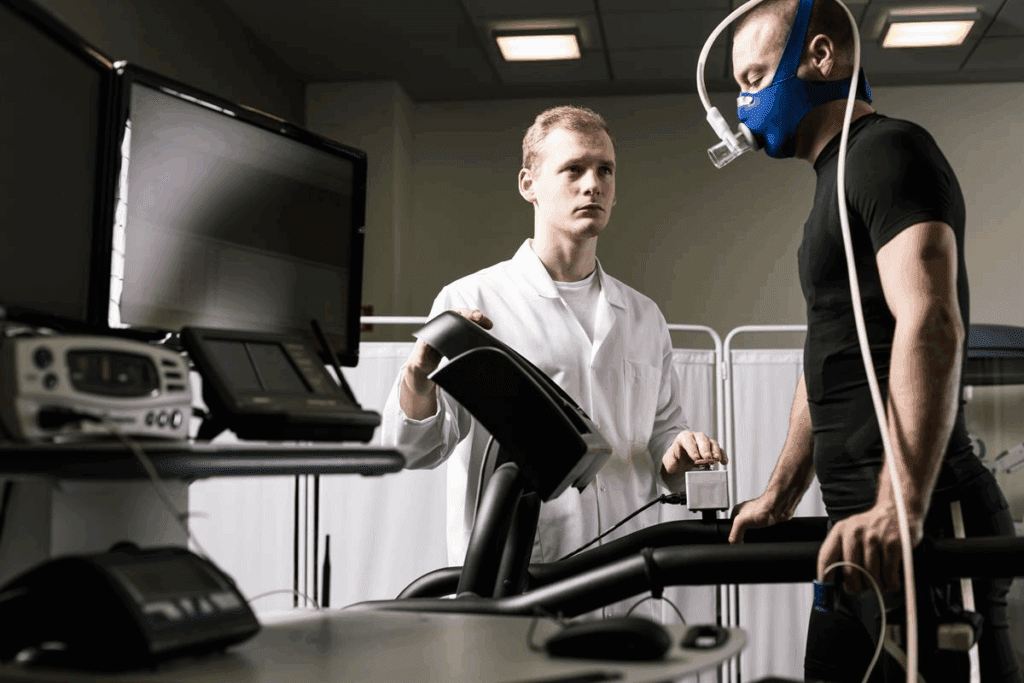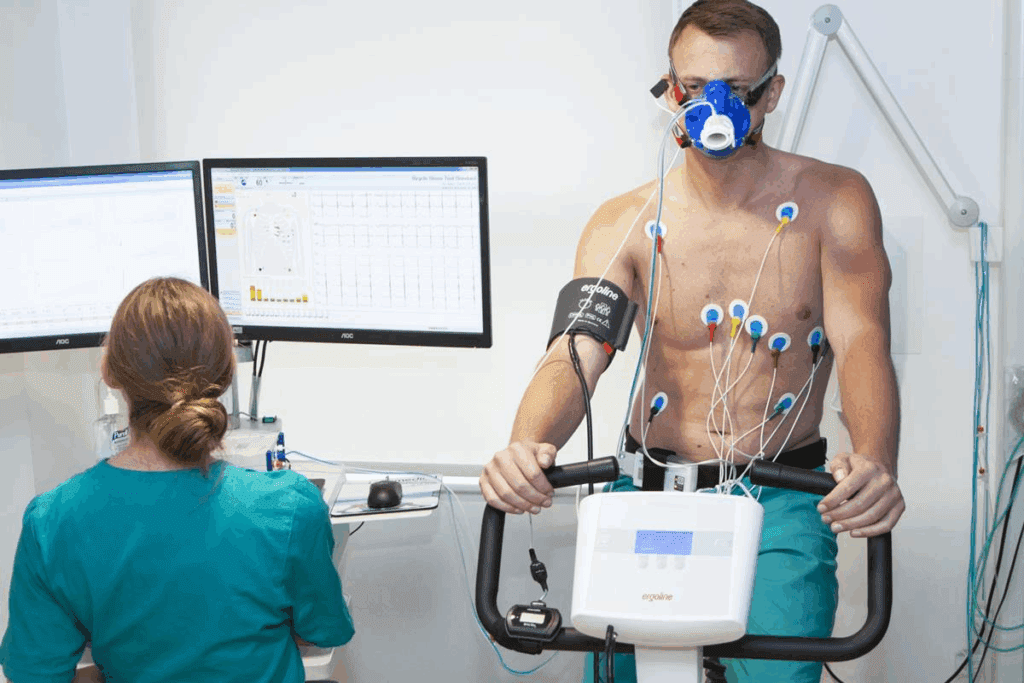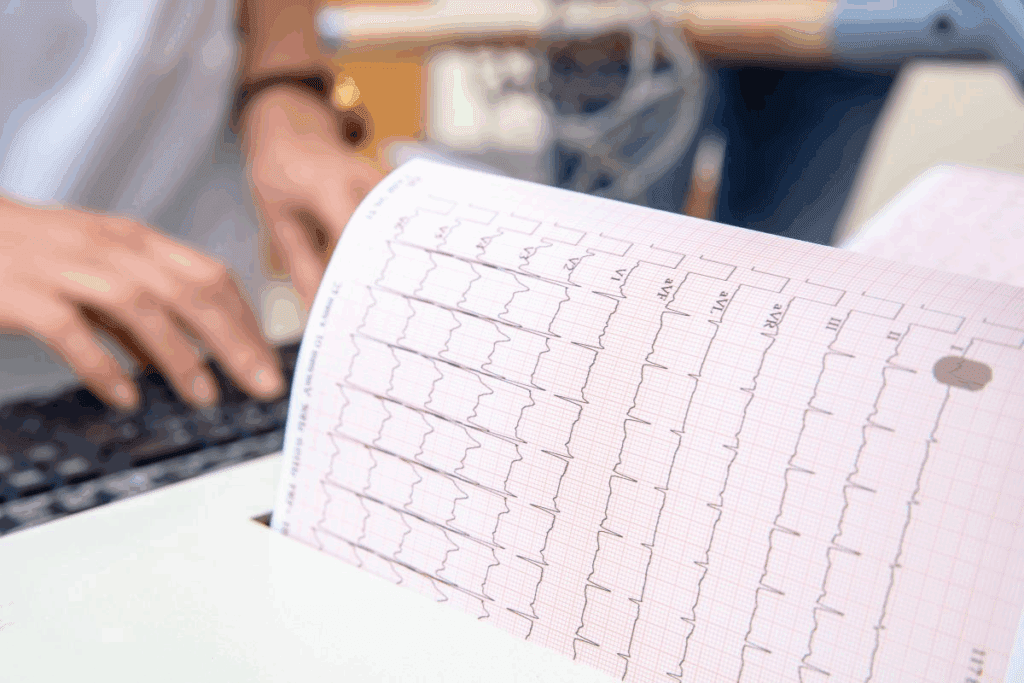Last Updated on November 25, 2025 by Ugurkan Demir

Learn how to read stress test results by age, heart rate, and risk indicators for better cardiac assessment.
Knowing your stress test results is key to understanding your heart’s health. At Liv Hospital, we help you make sense of your test outcomes. We consider your age and health when doing this.
We’ll show you how to understand your stress test results. This way, you can talk better with your doctor. A stress test checks how well your heart works when you’re active. It sees how well you handle exercise and how your heart reacts.

Cardiac stress tests are key tools for checking how well the heart works when stressed. They help find problems like blocked arteries and irregular heartbeats. They also check if treatments for the heart are working.
A cardiac stress test, or exercise stress test, is a non-invasive way to see how the heart handles activity. It’s done on a treadmill or stationary bike. The test watches heart rate, blood pressure, and symptoms while you exercise.
Key components monitored during a cardiac stress test include:
There are many types of cardiac stress tests, each with its own purpose. The most common ones are:
| Type of Stress Test | Description | Typical Use |
| Exercise Stress Test | Patient exercises on a treadmill or bike while being monitored | Assessing heart function during physical activity |
| Nuclear Stress Test | Uses a radioactive tracer to image the heart during stress | Evaluating blood flow to the heart muscle |
| Pharmacological Stress Test | Medications simulate exercise by increasing heart rate | For patients unable to perform physical exercise |
Stress tests are suggested for many reasons. They help find heart disease, check risks before surgery, and see if treatments work. They’re great for people with symptoms like chest pain or shortness of breath when they’re active.
Typical indications for a stress test include:
Knowing about different stress tests helps doctors make better choices for their patients.

Stress test results show how the heart reacts when we exert ourselves. Doctors look at several important factors to check our heart health.
Doctors watch how the heart works when we’re active. They check heart rate, heart rhythm, and blood pressure. This helps them see if our heart can handle the effort.
Many important factors are looked at in stress test results. These include:
Metabolic equivalents (METs) measure how well we can exercise. They show how much oxygen we use when we’re active. Knowing METs helps understand our fitness level.
A higher MET value means we can handle more exercise and have better heart health. METs help doctors:
Understanding stress test results is key. Doctors look at several important factors to check how well the heart works when stressed. Younger people usually do better in these tests than older ones.
Doctors compare your test results with those of others your age. They consider heart rate, ECG changes, and any symptoms you had during the test. This helps them see if your heart reacted normally for your age.
The first thing to do is look at the baseline ECG. This shows how the heart works when it’s at rest. Doctors check for any problems, like irregular heartbeats or signs of past heart attacks. These findings can affect how they read the stress test results.
Then, we look at how the heart rate changes during the test. A normal test shows the heart rate goes up as you work harder. It should reach its highest rate at the hardest part of the test. If the heart rate doesn’t go up enough, it could mean there’s a problem.
Checking blood pressure changes is also important. Normally, blood pressure goes up with exercise, but the bottom number stays the same or goes down a bit. If blood pressure changes too much, it could mean heart disease.
Lastly, we look at how well you can exercise. This is measured in METs, which show how well your heart and lungs work. Doctors compare your METs to what’s expected for your age and gender. If you don’t do as well as expected, it could mean health problems.
By following this guide, doctors can understand stress test results better. This helps them see how well your heart is working and how well you can exercise.
Stress test scoring systems help us understand heart health. They are key for spotting risks and checking how well the heart works.
The Duke Treadmill Score is a well-known tool. It predicts heart risks. It looks at how long you exercise, ST-segment changes, and if you feel chest pain.
A lower score means a higher risk. But a higher score shows less risk of heart problems.
ST segment depression is a big deal in stress tests. It’s when the ST segment on an ECG goes down. The more and longer it goes down, the worse the heart’s ischemia.
Heart rate recovery (HRR) is also key. It shows how fast your heart rate goes back to normal after exercise. A quicker recovery is a good sign for heart health.
Exercise capacity, measured in METs, shows how fit your heart is. More METs mean better health. We check it to see how well your heart works and how you feel.
Knowing these scoring systems helps doctors give better care. They can make plans that really help each patient.
Age affects how we respond to stress, which changes over time. This impacts what’s considered normal in stress test results. Knowing these changes helps doctors diagnose and treat better.
Adults under 40 usually show high fitness and heart health in stress tests. They reach higher heart rates and metabolic levels than older folks. This means they’re less likely to have heart disease.
Key indicators of a normal stress test in adults under 40 include:
For those 40-60, stress tests show a bit less fitness than the young. But, they should hit a good percentage of their max heart rate. Normal results include a steady blood pressure rise during exercise and no ECG signs of heart issues.
Older adults have lower heart rates and fitness levels in stress tests. Yet, they should show a good heart rate boost during exercise. Normal results include:
Studies show men and women have different stress test results. Women tend to have less fitness, even after adjusting for age. But, this doesn’t mean they’re at higher risk. It’s important to understand these differences for accurate test results.
| Age Group | Expected METs for Men | Expected METs for Women |
| 20-39 | 12-14 | 10-12 |
| 40-59 | 10-12 | 8-10 |
| 60+ | 8-10 | 6-8 |
Stress test results vary a lot with age and gender. Healthcare providers need to understand these differences to make the best decisions for patients.
Understanding a positive stress test result is key. It shows signs of heart problems, like not enough blood flow. This might lead to more tests to see how serious the issue is.
A positive test means your heart might not get enough blood when you’re stressed. This could mean big blockages in your heart’s arteries. More tests, like a coronary angiogram, might be needed to figure out what’s going on and how to treat it.
During a stress test, your heart’s electrical activity is checked. If it shows signs of trouble, like not enough blood, it’s a red flag. Common signs include:
These signs mean your heart might not get enough oxygen when you’re active.
Symptoms during a stress test are important too. If you feel:
Tell your doctor right away. These symptoms help understand the test results better.
After a positive test, more tests are usually needed. Your doctor might suggest:
These tests help find out how bad the heart disease is. They help decide the best treatment for you.
Nuclear stress tests give us important insights into heart health. Understanding these results is more complex as we get older. Our heart’s function changes with age, impacting how we read these tests.
Perfusion imaging is key in nuclear stress tests. It uses a radioactive tracer to see how blood flows to the heart. This method spots areas where blood flow is low, hinting at blockages or damage. The test shows how the heart works at rest and under stress, giving a full picture of heart health.
As we age, our hearts change naturally. Older adults might have less cardiac output or stiffer blood vessels. These changes affect test results, making age a key factor in interpretation. Knowing these changes helps doctors diagnose and treat heart conditions more accurately.
Perfusion defects show up as areas with less blood flow in nuclear stress tests. These can be reversible or fixed, with reversible ones often showing ischemia (reduced blood flow) during stress but not at rest. Doctors must consider age, medical history, and other factors to understand these defects’ meaning.
Quantitative analysis of nuclear stress tests uses software to measure heart function. This data offers a clear view of heart function and can track changes over time. By combining this analysis with clinical knowledge, doctors can make better care decisions.
The Bruce protocol is a top choice for stress tests. It’s known for its structured way of checking heart health. This protocol uses a treadmill to increase speed and incline to see how well the heart works when exerted.
The time on the treadmill can change a lot based on age and fitness. A healthy adult usually lasts 7-8 minutes. Younger people tend to do better than older ones.
The Bruce protocol has several stages, each getting harder. The test usually lasts 8-12 minutes. Here are the stages:
Knowing these stages helps understand the test results better.
The stage reached in the Bruce protocol test tells a lot about heart health. Important things to look at include the highest heart rate, blood pressure, and any symptoms during the test.
Key factors to consider:
Healthcare providers use these details to understand how well the heart works and the overall health of the patient.
When looking at stress test results for older adults, we must understand how aging affects the heart. As people get older, their heart’s reaction to stress changes. This makes it key to take these changes into account when diagnosing and treating.
For those over 70, stress test results need to be seen in light of age-related physical decline and health issues. We look at how aging affects heart rate, exercise ability, and blood pressure response.
Elderly patients might need special stress tests because of physical or health issues. These could include using medicine instead of exercise or adjusting the test’s intensity and length.
| Age Group | Expected METs | Typical Heart Rate Response |
| 70-79 | 4-6 METs | Lower maximal heart rate |
| 80+ | 3-5 METs | Significantly reduced heart rate response |
Consider a 70-year-old woman who had a stress test. She had high blood pressure and felt short of breath when exercising. Her test showed she could only do 4 METs and her heart rate didn’t respond much. There were no big changes in her ECG.
Based on these findings, more tests were suggested to check for heart disease.
Heart rate charts are key to understanding stress test results. They help doctors see how well the heart works during exercise. This information is important for checking heart health and finding any problems.
Target heart rate is very important during stress tests. It’s 85% of the maximum heart rate for your age. For example, a 40-year-old’s target heart rate is 153 beats per minute.
Target Heart Rate Calculation Example:
| Age | Age-Predicted Maximum Heart Rate | Target Heart Rate (85%) |
| 30 | 190 | 161.5 |
| 50 | 170 | 144.5 |
| 70 | 150 | 127.5 |
The maximum heart rate for your age is a key part of stress tests. The usual formula is “220 – age.” But remember, this is just an estimate and can differ from person to person.
Heart rate recovery (HRR) is very important. It’s how fast your heart rate goes down after exercise. A normal HRR is 12-22 bpm in the first minute. If it’s not normal, it could mean a higher risk of death.
Chronotropic incompetence means your heart can’t reach 85% of its maximum rate during exercise. This could be a sign of heart or nervous system problems. Doctors check this by looking at how your heart rate changes during exercise.
By looking at stress test heart rate charts, doctors can learn a lot about your heart health. They can see if you’re meeting your target heart rate, how your heart rate recovers, and if you have chronotropic incompetence. This helps them make better decisions about your care.
Understanding stress test results is key. It involves knowing about age, ECG changes, and how well someone exercises. Stress tests help see how well the heart works and how well someone can exercise.
We’ve shown how to read stress test results, looking at different ages and test types. Knowing how to interpret these results helps doctors make better choices for their patients. This leads to better care and outcomes for patients.
Getting the right conclusion from a stress test means looking at all the data carefully. We must consider the person’s health history and test results. This way, we can spot heart problems early and treat them quickly.
To read a stress test result, look at heart rate, blood pressure, ECG, and how well you exercise. These are checked against your age and health.
Normal results change with age. Younger people usually do better. For those under 40, 10-13 METs are good. Over 70, 6-8 METs are okay.
A positive test might show heart issues, like coronary disease. It shows ECG problems, symptoms, or a low heart rate.
Nuclear tests look at heart blood flow images. They check for blockages. Age and how bad the defects are are considered.
The Bruce protocol is a treadmill test that gets harder. It checks how well you exercise and your heart. The test’s intensity and how long you last are key.
For older patients, consider age, health issues, and how well they can exercise. Modified tests might be used. Results are based on the patient’s health.
Heart rate charts help understand heart rate during exercise. They check if the heart rate is good and if there are any problems.
Scoring uses systems like the Duke treadmill score. It looks at exercise, ECG, and symptoms. This gives a full picture of heart health.
Stress tests are physical or use medicine. Physical tests are on a treadmill. Medicine tests mimic exercise without it.
For a 70-year-old woman, look at age, health, and test results. Consider exercise, ECG, and symptoms. Modified tests might be used.
Subscribe to our e-newsletter to stay informed about the latest innovations in the world of health and exclusive offers!